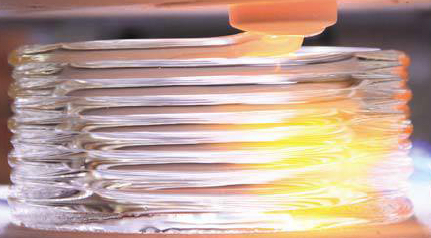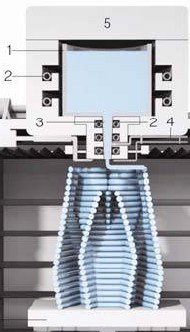MIT researchers invent process for 3D-printing complex transparent glass forms
August 21, 2015

Printing molten glass (credit: John Klein et al./3D Printing and Additive Manufacturing)
An additive-manufacturing glass-printing process called G3DP (Glass 3D Printing) has been developed by researchers in the Mediated Matter Group at the MIT Media Lab in collaboration with the Glass Lab at MIT.

Glass-printing platform. (1) Crucible, (2) heating elements, (3) nozzle (4) thermocouple, (5) removable feed access lid. (credit: John Klein et al./3D Printing and Additive Manufacturing)
The platform is based on a dual heated-chamber concept. The upper chamber acts as a Kiln Cartridge (a thermally insulated heater) operating at about 1900°F to melt the glass, while the lower chamber serves to anneal (form) the structures. The molten material gets funneled through an alumina-zircon-silica nozzle, which extrudes the material onto a build platform, where it cools and hardens. By tuning the form, transparency, and color variation, the process can drive, limit, or control light transmission, reflection and refraction in the final material.

Detail of a colored printed object (credit: John Klein et al./3D Printing and Additive Manufacturing)
The G3DP project was created in collaboration between the Mediated Matter group at the MIT Media Lab, the Mechanical Engineering Department, the MIT Glass Lab, and the Wyss Institute.
A selection of Glass pieces will appear in an exhibition at Cooper Hewitt, Smithsonian Design Museum, New York City in 2016. An “Additive Manufacturing of Optically Transparent Glass” patent application was filed on April 25, 2014.
Mediated Matter Group | GLASS
